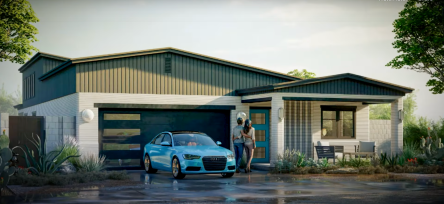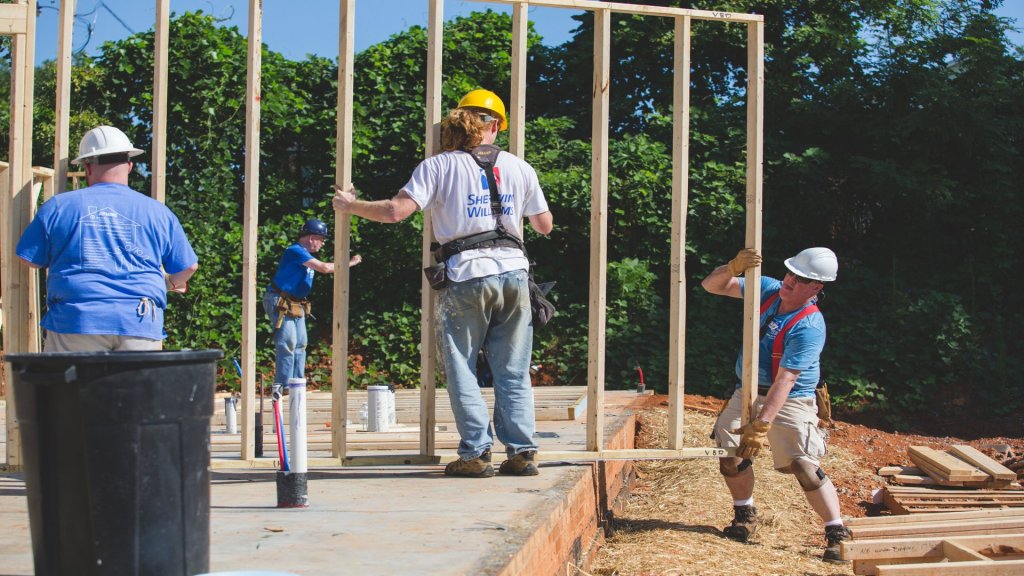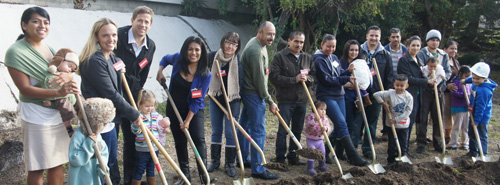Habitat for Humanity is leading the way on innovative housing solutions. The Tempe branch is exploring 3D-printed ranch-style homes to address a growing need for housing. The flagship structure demonstrates the efficiency and beauty of combining conventional and 3D printer construction. It takes a village to print a 3D house The three-bedroom, two-bathroom house was designed by Scottsdale-based Candelaria Designs and printed by PERI group of Germany using a Build On Demand (BOD2) printer. More than 20 sponsors provided funding. The house contains 1,738 square feet of living space and a total of 2,433 square feet for the project, reports the nonprofit. Of the total square footage, 70-80% of the house will be 3D printed. The BOD2 works alongside construction crews and volunteers. It uses the gantry principle, which allows it to move in any position within the structure, printing inner and outer walls in thin layers. As it prints, human workers can continue their electrical, plumbing and other tasks. Humans will also install the ceilings. Construction is scheduled for completion in October 2021. Explore Habitat for Humanity’s earth-friendly passivehaus design. For now, the BOD2 house at 677 W. 19th St. will be one-of-a-kind. The 15 adjacent homes will be traditional builds on four city lots. Habitat for Humanity has made it clear that more 3D-printed homes are of interest. The project is a direct response to an acute affordable housing crisis in the area, reports the nonprofit. About 20% of renters are considered extremely low income. Of them, 75% of households are severely cost burdened. The phrase is used by the National Low Income Housing Coalition to describe renters spending more than 30% of their income on housing. The state would need more than 136,000 affordable units to safely house extremely low-income renters. Scalable, affordable...
A Mission in Action
Grubb Giving + Habitat for Humanity
When a company’s mission statement is pulled from the page and implemented in daily life, it can transform the world. Grubb Properties’ vision statement encourages “working together to enhance life and community.” To fulfill that mission, Grubb Properties has teamed up with Habitat for Humanity. Together, they enhance life and community by building homes for those in need. In 2018, the North Carolina-based property manager and developer committed to build one Habitat home per year for ten years. Each home is built in cities where Grubb Properties has a presence. Grubb Properties, Yardi + Habitat for Humanity unite The 2018 build took place in Winston-Salem, NC followed by a 2019 build in Greenville, SC. Shawn Cardner, executive vice president, multifamily operations and information technology at Grubb Properties participated in the Greenville build. He was joined by Yardi team members Paul Yount, industry principal, sales and Jim Hill, director of consulting practices. “Paul and Jim were instrumental in garnering support from Yardi. We are incredibly thankful for Yardi’s financial contribution. To be honest, though, even more impactful was the commitment of time, energy, and travel that Yardi team members made to participate,” says Cardner. Habitat schedules several build days for a given house project. Each day requires at least 20 volunteers for framing, roofing, finishes, landscaping and more. To assist Grubb Properties volunteers, several Yardi employees made the three-to-four-hour drive from Raleigh to Greenville. In addition to Hill and Yount, Yardi volunteers included Zach Smith, Edward McNamee, Terry Judd, and Lucas Bader. “On top of the long drive, they then spent seven hours on the jobsite with temperatures near 100 degrees. It’s one thing to write a check and then tell people how charitable you are. It’s a much more impactful statement when you contribute your time, energy, blood and sweat for something. We’re thankful that Yardi contributed in both ways!” says Cardner. The heart of giving “We all felt a sense of accomplishment at the end. We started from an empty concrete slab and ended the day with all of the interior and exterior walls built and external sheathing attached as well,” reflects Hill. “We enjoyed spending the day with the Grubb team, the Habitat sponsor family and Habitat volunteers. We all worked as a team. Seeing the finished job was pretty amazing.” Cardner adds, “As a member of our executive team, I’m just thrilled at the way all our employees, communities, and partners come together to work on a shared project. Grubb employees volunteered 368 hours on that build. Our employees also donated $7,055 to it which is just over 10% of the total amount raised through partner sponsorships. I’m incredibly proud to work with such incredibly generous and thoughtful people.” Grubb + Yardi, beyond the software The relationship between Grubb Properties and Yardi began as any B2B relationship would. Yardi provided a service and Grubb paid for it. But over the years, the relationship developed into a mutually supportive partnership. “Folks like Jim, Paul and Stephen Witek have worked tirelessly to develop the partnership that we have today. I don’t use the word partnership lightly. I know Yardi believes that the best way for it to succeed is to help companies like us succeed.” Hill adds, “At Yardi, nurturing client relationships is paramount. Additionally, Yardi is blessed to have the encouragement of Anant Yardi to support local philanthropic projects in the communities where we live. The local impact in our neighborhoods adds a level of personal pride at working at Yardi and in helping our clients and communities at the same time.” Continuing the good work “In the end, the best way to describe Grubb Properties’ stance on philanthropy is just to say it’s who we are,” explains Cardner. “It’s what our leadership believes in. It’s what our employees believe in. It’s even a characteristic of the residents we try to attract to our properties. We want to...
Habitat for Humanity
Building Homes and Futures
Sometime in 2014, 12 low-income Santa Barbara families will be able to move into newly constructed homes at Canon Perdido and Milpas streets, structures that they own and built in part with their own sweat equity. The latest project from Habitat for Humanity of Southern Santa Barbara County, the Canon Perdido Homes are the non-profit’s largest construction effort to date, and will allow its residents to leave behind the sub-standard conditions they are currently living in. “This is our largest project to date. These homes will provide housing for 43 people, 20 of whom are children,” said Alex Ramstrum, Development Manager for Habitat for Humanity of Southern Santa Barbara County. The project broke ground in mid-December and completion is expected to take about 18 months. Most of the construction will be the work of volunteers and the future homeowners, who will work under the tutelage of a professional contractor foreman and expert craftsmen volunteers. Each adult must contribute 250 hours of labor time toward their future residence. A popular volunteer opportunity for hundreds of community members each year, Habitat needs people power not only to participate in construction projects, but to help staff its ReStore, a retail center for recycled building materials in Goleta, and to participate in “A Brush with Kindness”, which completes exterior maintenance projects for homeowners in need. Here are the income level maximums for Brush with Kindess recipients. Yardi has had several employee “build” days with Habitat. The largest group was a team that worked for a day swinging hammers on the San Pasqual project in 2010. Other groups have worked at the ReStore. Rob Teel , Yardi’s Senior Vice President of Global Solutions, serves on the organization’s Board of Directors. “For me, Habitat is the perfect charity to combine my work, local, and ethical interests. The idea of providing a home for a family not only builds hope for those individuals, but it has a major impact on the health and hope of the surrounding community,” Teel said. Opportunities to volunteer on the Canon Perdido construction project will commence in the spring after underground construction is complete and foundations are laid, Ramstrum said. Interested volunteers can register to donate their time at this link. Donations for the project are still being collected as part of the Building Homes, Building Hope campaign. The development includes 2 three-bedroom units, 8 two-bedroom units, and 2 one-bedrooms, one of which will be accessible to disabled persons. The units will range between 750 and 1,200 square feet each. To qualify for a home in the project, the selected families went through an intensive selection process that included interviews, visit to their current housing situation, and financial review to ensure they met the income criteria for Habitat homeowners. Selected families can make no more than 80 percent of the region’s median income, many make far less. Demonstrating the need for affordable housing in South Santa Barbara County, hundreds of people attended early meetings about the Canon Perdido project, and eventually the 12 families selected were chosen from 115 applications. In addition to contributing 250 hours of labor per person toward their homes, the families will pay off interest-free mortgages carried by Habitat for Humanity. Mortgage costs never exceed 35 percent of residents’ incomes. Yardi Systems has been a corporate supporter of the South Coast’s Habitat chapter since 2007, donating funds toward all three of the non-profit’s local housing projects. Previous Habitat developments are located on the Westside of Santa Barbara on San Pasqual Street and off of Upper State Street on Via Lucero. For the Canon Perdido project, Yardi’s contributions will pay for the doors and windows of the homes, which are designed to meet the environmental standards of Built Green Santa Barbara. Building methods and construction materials will create well-insulated structures that lead to utility savings for the homeowners. The goals is to achieve “net zero” energy usage by...



